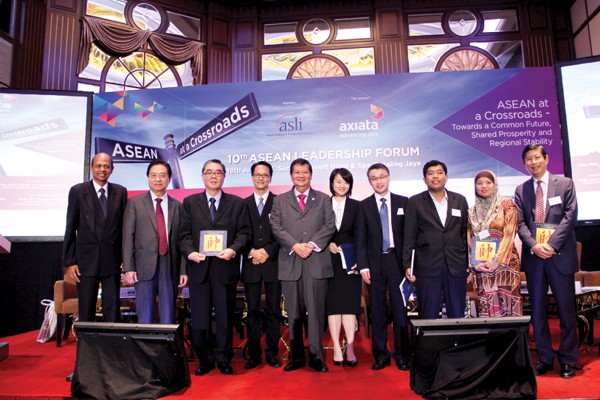2013-07-23
Jennifer Lo

China’s Lenovo and India’s Tata group are among a handful of huge Asian companies that are widely known around the world. But such household names do not give the full picture, as these giants coexist with a large population of successful small and medium enterprises (SMEs), which form the backbone of the region’s economies. In fact, SMEs account for as much as 85 percent of employment and contribute up to 53 percent of GDP in many Association of Southeast Asian Nations (ASEAN) countries. SMEs in China, meanwhile, make up more than 99 percent of all enterprises in the country. The China-ASEAN Free Trade Area (CAFTA), which came into effect in January 2010, has had considerable impact, presenting tremendous opportunities, but also threats, to the region’s SMEs. CAFTA is the world’s largest free trade area in terms of population — 1.9 billion people — and has a GDP of more than $9 trillion. It is also the third largest in terms of trade volume, after the European Union and the North American Free Trade Area. Nonetheless, some SMEs in the region are still unaware of the potential it offers. “One challenge is about educating people about CAFTA and what it means for businesses,” said Ong Keng Yong, Singapore high commissioner to Malaysia and former ASEAN secretary general, speaking at the China Daily Asia Leadership Roundtable event on “China-ASEAN Business and Economic Partnership” on July 18, held on the sidelines of the 10th ASEAN Leadership Forum in Kuala Lumpur. Recent surveys by the ASEAN Secretariat indicated that one-third of the business community lacked basic understanding of the ASEAN Economic Community, which will kick off in less than two years time, and the benefits of free trade agreements with major trading partners such as China. “The CAFTA is certainly a good start,” said David Chua, executive advisor of the Associated Chinese Chambers of Commerce and Industry of Malaysia (ACCCIM). “But it takes time to sink in and for SMEs to adjust (their strategies).” Under CAFTA, tariffs on over 90 percent of products and services traded between China and six ASEAN countries including Brunei, Indonesia, Malaysia, the Philippines, Thailand and Singapore have been removed. In 2015, four newer ASEAN members — Vietnam, Laos, Cambodia and Myanmar — will join the agreement. Such a closer China-ASEAN tie is of particular importance to some of the region’s developing nations, explained Ken Chanthan, former president of the Young Entrepreneurs Association of Cambodia and the CEO of the Ken Group of Companies. “Cambodia is a relatively small market,” said Chanthan, “ASEAN (partnerships) and free trade agreement with China have enabled Cambodia to expand our market.” Promoting free trade would also mean opening up domestic markets to regional competition. But this need not be bad news; rather it could act as a spur for ASEAN countries to raise their game. Developing a niche market is one way of competing with the “big boys” in the region, argued Hafimi Abdul Haadii, president of the Young Entrepreneurs Association in Brunei. With a population of just half a million, “(Brunei) is smaller than a Chinese village,” Haadii said. Brunei entrepreneurs are looking into producing unique products from specialized pillow cases to handbags, or kain tenunan, a detailed embroidered woven cloth that is exclusive to the country. Dicky Yip, Asia Pacific chief representative for the Institute of International Finance, recognizes the difficulties for cross-border SME business between China and ASEAN. “For SMEs to go abroad (they need) a lot of support and energy,” he said. SME support needed The fact that every country has its own definition of SMEs poses a challenge to meet entry requirements overseas. “In China, SMEs by definition can be very big,” Yip explained. This view is echoed by business communities in Malaysia. “SMEs in China could be a multinational in ASEAN countries,” said Abdul Majid Khan, president of the Malaysia-China Friendship Association, based in Kuala Lumpur. So far, there is no universal criterion of an SME. In China, companies with up to 2,000 staff and assets of less than 400 million yuan ($65 million) are still classified as SMEs. Yet a medium-sized firm in Cambodia could have just 200 employees and fixed assets of $500,000. SMEs in the region are also affected by barriers to market access. More than a decade ago, the Chinese government announced the “going out” strategy to encourage domestic enterprises to invest overseas. The policy has been a success in promoting China’s SMEs abroad. Nonetheless, a great disparity in capital flow is seen in some parts of ASEAN. “Chinese investment in Malaysia and Malaysian investment in China is probably in the ratio of just 1:10, largely favoring the Chinese,” observes ACCCIM’s Chua. In Malaysia alone, Chinese foreign direct investment amounted to $370 million in 2011. This is compared to $6.2 billion of Malaysian investment in China in the same year. To put things in perspective, Chinese investments in ASEAN surged to $5.9 billion in 2011, up from just $120 million in 2003. By mid-2012, China had invested $18.8 billion in ASEAN. Not surprisingly, China has emerged as Indonesia’s second-largest trading partner after Japan. As in Myanmar, investors from China already account for the largest share of foreign investment. Looking ahead, ASEAN still represents a market of potential for Chinese SMEs. From Indonesia’s timber to Malaysia’s palm oil, “China will find ASEAN attractive in the sense that we have lots of natural resources,” said Michael Yeoh, CEO of the Asian Strategy & Leadership Institute, a Malaysian independent think tank. For decades, countries in ASEAN have nurtured friendly business ties with China, thanks to cultural similarities. In practically every ASEAN country, ethnic Chinese people constitute a large proportion of the business community. “It makes it easier to do business because we speak the same language,” Yeoh added.